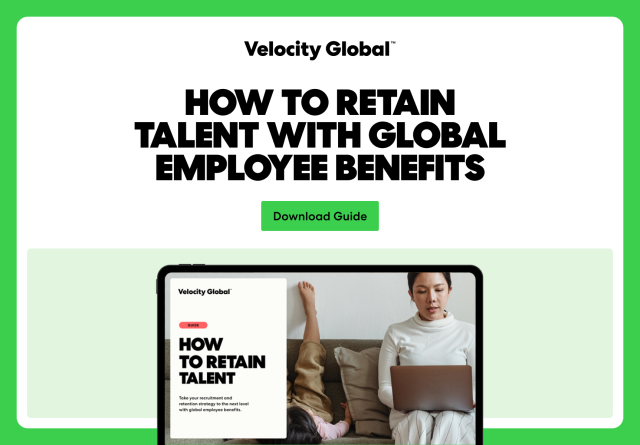Paid maternity leave undoubtedly improves employee well-being and talent retention, making it a key employee benefit that companies should offer to talent across the globe.
Several countries guarantee employees fully paid maternity leave, while others offer partial payment—but some countries don’t mandate paid maternity leave at all.
Global HR teams face the unique challenge of administering competitive leave packages to attract and secure top talent while ensuring compliance with leave mandates in each country where they hire talent.
This guide breaks down unpaid and paid maternity leave by country and outlines the key considerations for administering supplemental parental leave to a global workforce.
Countries with 100% paid maternity leave
Maternity leave requirements vary by country, with differences in leave duration and compensation.
Below is a list of countries that guarantee new mothers 100% of their salary or wage throughout the entire maternity leave period:
| Austria | 16 weeks (8 weeks before the expected delivery date and 8 weeks after birth) |
| Brazil | 17 weeks (leave can begin 28 days before the expected due date) |
| Chile | 18 weeks (6 weeks of paid prenatal leave and 12 weeks of paid postnatal leave) |
| Colombia | 18 weeks (flexible system allowing mothers to take leave 1-2 weeks before delivery) |
| Costa Rica | 16 weeks (or about 4 months; 1 month before the due date and 3 months after birth) |
| Croatia | 14 weeks (4 weeks before expected delivery and 10 weeks after birth) |
| Estonia | 14 weeks (or 100 days; 70 days before the expected date of birth and 30 after the birth) |
| Hungary | 24 weeks (up to 4 weeks before delivery. Two weeks are obligatory) |
| France | 16 weeks (6 prenatal weeks and 10 postnatal weeks) |
| Germany | 14 weeks (6 prenatal weeks and 8 postnatal weeks) |
| India | 26 weeks (for the first two children, divided into 8 prenatal and 18 postnatal weeks) |
| Israel | 26 weeks (15 weeks of paid leave, and the remaining 11 weeks can be taken as unpaid leave) |
| Malaysia | 14 weeks (requiring leave commencement no earlier than 30 days pre-delivery) |
| Mexico | 12 weeks (6 weeks prenatal and 6 weeks postnatal leave) |
| Netherlands | 16 weeks (4-6 weeks before the expected delivery date, and 10-12 weeks after birth) |
| New Zealand | 26 weeks (can be shared between parents) |
| Philippines | 15 weeks (extendable to 120 days for solo parents and 60 days for miscarriages) |
| Poland | 20 weeks (extending to 31 weeks for twins and 37 weeks for triplets) |
| Portugal | 17 weeks (mandatory 6 weeks post-birth, while fathers receive 28 days [7 mandatory post-birth]) |
| Singapore | 16 weeks (leave must start 4 weeks pre-delivery, with the final 8 weeks flexible over 12 months) |
| Slovenia | 15 weeks (additional 260 days of parental leave can be shared between parents) |
| Spain | 16 weeks (6 weeks mandatory post-birth and the remainder flexible within 12 months) |
Countries with no paid maternity leave
On the other hand, five countries offer no federal guarantees of compensation for maternity leave. Below is a list of these countries:
| United States |
| Marshall Islands |
| Micronesia |
| Palau |
| Papua New Guinea |
| Nauru |
| Niue |
| Suriname |
| Tonga |
The longest paid maternity leaves by country
The following countries offer the longest maternity leave duration:
| Sweden | 69 weeks or 480 days (first 390 days at 80% income; SEK 180 per day for remaining 90 days) |
| Bulgaria | 58.6 weeks or 410 days (starting 45 days pre-birth; 90% of average gross salary for the first 135 days) |
| United Kingdom | 52 weeks (paid for up to 39 weeks: 90% of their average weekly earnings [AWE] for the first 6 weeks and £187.18 or 90% of AWE for the remaining 33 weeks) |
| Canada | 50 weeks at 55% pay (15 weeks at 55% pay, plus 35 weeks at 55% or 61 weeks at 33% pay) |
| Norway | 49 weeks at 100% pay (or 59 weeks at 80% pay) |
| Slovakia | 34 weeks (extended to 37 weeks for single mothers; 75% pay of average earnings from the prior year) |
| Czech Republic | 28 weeks (37 weeks for multiples with 70% pay) |
| Croatia | 14 weeks (100% salary coverage based on the prior six months’ earnings) |
| New Zealand | 26 weeks (paid leave at $754.87/week, requiring 6–12 months of employment) |
| Greece | 17 weeks (or 4 months with pay equal to the minimum wage for its first two months) |
Download our guide to learn how offering comprehensive benefits packages that include supplemental paid parental leave and other meaningful benefits helps you attract and retain top talent:

Maternity leave in the United States
The U.S. provides fewer maternity leave protections than any other industrialized nation.
The Family Medical Leave Act (FMLA) requires employers with 50 or more employees to offer workers a minimum of 12 weeks of unpaid maternity leave each year. However, this is the country’s only federal mandate governing parental leave.
U.S. federal law generally treats parental leave as a supplemental benefit, leaving specific leave conditions up to employers.
Despite the lack of federal guarantees, several U.S. states offer additional maternity leave protections beyond the FMLA minimums.
U.S. States with paid maternity leave
The following U.S. states offer qualifying employees additional maternity leave benefits:
| California | 8 weeks at 60% to 70% pay, depending on the income level |
| Colorado | 12 weeks at 90% pay, capped at the maximum weekly benefit of $1,324.21 |
| Connecticut | 12 weeks at 95% of the minimum wage plus 60% of earnings above the minimum wage, capped at $981 per week |
| Delaware | 12 weeks at 80% pay, capped at $900 per week (starting in 2026) |
| Massachusetts | 12 weeks at about 80%, capped at $1,170.64 per week |
| Maryland | 12 weeks at varying pay rates, capped at $1,000 per week (starting in 2028) |
| Maine | 12 weeks set at 100% of the Maine state average weekly wage (SAWW), which is $1,144.67 for 2025 |
| Minnesota | 12 weeks at up to 90% pay, depending on the income level (starting in 2026) |
| New Jersey | 12 weeks at 85% pay, capped at $1,081 per week |
| New York | 12 weeks at 67% pay, capped at $1,757.19 per week |
| Oregon | 12 weeks calculated based on wages, capped at $1568.60 per week |
| Rhode Island | 6 weeks at about 60% pay for 4 weeks |
| Washington | 12 weeks at 90% pay, capped at $1,542 per week |
| Washington DC | 12 weeks calculated based on weekly wages, capped at $1,153 per week. |
Additionally, South Carolina offers 6 weeks of paid parental leave equal to an eligible state employee’s base pay.
Maternity leave in other countries around the world
In addition to the countries we covered above, below is a list of maternity leave benefits in several other countries:
| Australia | 22 weeks at the national minimum wage |
| China | 14 weeks at 100% pay |
| Italy | 20 weeks at 80% pay |
| Saudi Arabia | 10 weeks at 100% pay |
| Thailand | 14 weeks at 100% pay for the first 45 days |
| United Arab Emirates | 8.6 weeks (or 60 days; 45 days will be fully-paid leave and 15 days will be half-paid leave) |
Which countries offer paid paternity leave?
Maternity leave has been a standard employee benefit worldwide for more than a century. However, many countries have also started offering paternity leave benefits within the past decade.
The cultural ideology of parental leave is evolving, and fathers are taking on a more significant role in raising their children. In 2023, about half of the countries worldwide offer statutory paid paternity leave.
The following countries offer the most generous leave entitlements to new fathers:
| Canada | Up to 40 weeks (Shared parental leave at 55% wages or up to $695 per week. Extended leave offers up to 69 weeks at 33% wages or up to $417 per week) |
| Estonia | 4.3 weeks at varying rates, depending on how much social tax the employee pays, capped at €5265.09 |
| France | 3.6 weeks at about 70% pay, capped at €3,925 per month |
| Iceland | 26 weeks at 80% pay, capped at ISK 700,000 per month |
| Japan | 4 weeks at 67% pay, capped at ¥15,190 per day, extendable up to 52 weeks |
| Lithuania | 4.3 weeks at 77.58% pay |
| Norway | 49 weeks at 100% pay (or 61 weeks at 80% pay) split between maternal and paternal quotas |
| Slovenia | 130 days at 100% salary (but may not be more than 2.5 times the amount of the average monthly wage) |
| Spain | 16 weeks at 100% pay |
| Sweden | 390 days at 80% income (90 days exclusively reserved for each parent and 300 days shared between parents) |
Like maternity leave, paternity leave benefits are vital to international talent acquisition and retention strategies.
Read also: Guide to Paternity Leave in Europe
Providing supplemental maternity and paternity leave: Considerations for global companies
International companies seeking to offer supplemental parental leave to their global workforce enjoy advantages like greater talent retention. However, they also face risks, such as noncompliance.
Below, we outline the key considerations for administering supplemental parental leave to an international workforce.
Attract and retain top talent
Today, talent desires more than essential statutory benefits. They seek an employer who can provide peace of mind, improve their quality of life, and make them feel valued at work.
While global expansion provides employers with access to a larger talent pool, it also means increased competition for talent. Offering supplemental parental leave strengthens your global benefits offering and gives you a competitive edge for attracting and retaining top talent in any market. So don’t let the basic requirements outlined in this comparison of paid maternity leave by countries be your only guideline.
Support employees’ mental health and well-being
By offering additional parental leave, global employers leave a lasting impact on their employees’ financial security and mental health.
Supplemental parental leave enhances employees’ financial security as they navigate the challenge of raising children, especially in jurisdictions where the statutory minimums fall short.
With the added peace of mind, employees feel valued and become more loyal, engaged, and productive when they return to work.
Maintain compliance with international employment laws
Employment laws vary worldwide, posing significant compliance risks for companies operating or hiring talent in multiple jurisdictions.
When administering parental leave benefits to global teams, international organizations must navigate the local employment laws of each country where they engage talent.
Inadvertently overlooking local regulations leads to fines, limited business opportunities, and other noncompliance penalties.
Learn more: How to Stay Compliant When Hiring Internationally
Work with a global employee benefits partner
The simplest way to provide locally tailored parental leave benefits while ensuring compliance across multiple jurisdictions is to partner with an employer of record (EOR).
An EOR is a third-party organization that supports global companies throughout the entire lifecycle of international expansion, from hiring and onboarding to running global payroll and providing ongoing HR support.
A vetted EOR has the local knowledge to advise on region-specific parental leave requirements and norms while administering global benefits and ensuring compliance on your behalf.
By partnering with an EOR, you can compliantly build and support global teams without increasing your workload.
Learn more: What Is an Employer of Record (EOR)?
Simplify benefits administration with Velocity Global
Administering parental leave benefits for international teams is a nuanced endeavor that involves serious compliance risks. Eliminate the complexity and risk by partnering with Velocity Global.
Velocity Global’s integrated Global Benefits solution provides curated, competitive benefits to talent in 185+ countries. Our team of experts crafts and administers locally tailored rewards packages that attract top candidates and comply with international labor laws.
As a part of our EOR solution, we also handle onboarding, payroll, ongoing HR support, and risk mitigation on your behalf so you can quickly grow and support your international workforce with peace of mind.
Contact Velocity Global to learn how to administer and manage parental leave benefits worldwide with ease.
This information does not, and is not intended to, constitute legal or tax advice and is for general informational purposes only. The intent of this document is solely to provide general and preliminary information for private use. Do not rely on it as an alternative to legal, financial, taxation, or accountancy advice from an appropriately qualified professional. The content in this guide is provided “as is,” and no representations are made that the content is error-free.
© 2025 Velocity Global, LLC. All rights reserved.
Topic:
Employee Benefits



